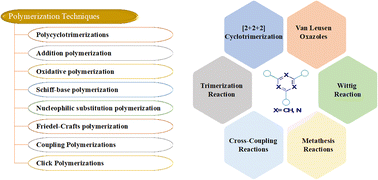An overview of the synthetic strategies of C3-symmetric polymeric materials containing benzene and triazine cores and their biomedical applications
Abstract
C3-symmetric star-shaped materials are an emerging category of porous organic polymers with distinctive properties such as permanent porosity, good thermal and chemical stability, high surface area, and appropriate functionalization that promote outstanding potential in various applications. This review is mostly about constructing benzene or s-triazine rings as the center of C3-symmetric molecules and using side-arm reactions to add functions to these molecules. Over and above this, the performance of various polymerization processes has been additionally investigated in detail, including the trimerization of alkynes or aromatic nitriles, polycondensation of monomers with specific functional groups, and cross-coupling building blocks with benzene or triazine cores. Finally, the most recent progress in biomedical applications for C3-symmetric materials based on benzene or s-triazine have been summarized.

- This article is part of the themed collection: 2023 Reviews in RSC Advances


 Please wait while we load your content...
Please wait while we load your content...